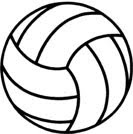by Chris Wright
Often times you find yourself and your team in a rut. You and your team may be doing everything right but no matter what, it seems you just can't break the run your opponents are on. Frustration starts building, you and your teammates start feeling on edge, and you wonder, "How could our team have blown such a large lead?" or, “This is just no fun at all.”
FINALLY, your team gets the serve and now is your chance to get out of that rut and hopefully regain the lead or at least have a respectable showing. But alas, it was not meant to be as your server just served the ball straight into the net. Talk about frustrating!
Many times during the service, the server feels they need to serve as hard as they can or simply feel the serve should be a "kill" opportunity, or someone is trying to impress everyone. While it definitely is a chance to score, the serve is so much more. When your server fails to get the serve over the net, or hits the ball out of bounds, it is the biggest momentum killer there is. Though it sounds pretty obvious, it seems many people forget that the most important part of the serve is to simply get your serve in.
Don't get me wrong, if you are good enough to perform a highly consistent jump serve, then by all means go for it. But a jump serve generally takes a somewhat higher toss, an approach, and timing your jump. Compound it by trying to actually aim the serve and temper it with the right amount of power and you have a recipe for a very inconsistent serve.
It has been my experience that, while some can execute a few killer jump serves for a few uncontested points, their run ultimately ends by a bad serve. When this happens, your team never really felt like they gained momentum or any sense of control, as they just stood there, while you tried to take it upon yourself to win the game with your serving. You may have gotten two or three uncontested points, but your successful serve percentage tends to be quite low.
For these reasons, I am a strong advocate of the floater serve. In my case, the floater serve starts with a low toss and little movement. This in itself makes the serve easier on the server to place the ball and get good contact on the ball. I find the floater to be extremely consistent, it can be just as likely to get uncontested points, and it is more likely to frustrate your opponents then most serves.
A typical jump serve or any hard serve with rotation, the only difficulty is really getting to the ball in time. If you can get there, it’s a fairly easy serve to pass. Contrast this with a floater. The floater always looks like a slow, soft serve that should be easily returned. However, if done correctly with no rotation on the ball, the ball can suddenly drop, float farther than expected, or shift from side-to-side in mid air, making it difficult to judge exactly where it is going and make it hard to pass correctly.
If your teammate fails to return a killer jump serve, you just shrug it off as a lucky serve. On the other hand, nothing frustrates a team more than watching one of their players shank what appeared to be a very easy serve or fail to get under the ball when it just kind of floated there for so long, but that is what often happens with a floater. It can rob a team of momentum.
Now, you most likely won't get much adulation from your teammates when the other team makes a poor pass of your soft, slow, easy-appearing serve. They may think the other team is just messing up. But you'll know it when your serve was the reason. Even if the other team handles your floater serve, you have put the responsibility on them to convert and your teammates will not feel like you blew their chances of staging a comeback or failed to put the nail in the coffin. That is why I find always serving the floater to be the best way to go for me.
Tuesday, July 27, 2010
The Floater Serve
Labels:
drop,
float,
jump serve,
killer,
momentum,
pass,
rotation,
serve,
side-to-side
Subscribe to:
Post Comments (Atom)





No comments:
Post a Comment